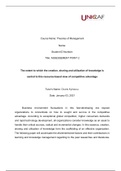Course Name: Theories of Management
Name:
Student ID Number:
Title: ASSESSEMENT POINT 2
The extent to which the creation, sharing and utilization of knowledge is
central to this resource-based view of competitive advantage
Tutor’s Name: Charis Kyriacou
Date: January 03, 2021
Business environment fluctuations in this fast-developing era expose
organizations to concentrate on how to sought and survive in the competitive
advantage. According to exceptional global competition, higher consumers demands
and rapid technology development, all organizations consider knowledge as an asset to
handle their critical sources, radical and incremental changes. In this essence, creation,
sharing and utilization of knowledge form the scaffolding of an effective organization.
The following paper will accentuate the aforementioned factors and their contributions in
learning and knowledge management regarding to the past researches and literatures.
,Subsequently, it will evaluate the role of them along with culture, leadership and
technology in resource-based view of competitive advantage.
According to Dasgupta and Gupta (2009), innovation is the creation of a new
and valuable idea. Innovation is sometimes mistaken with term “invention” which
defined as design and fabricate the new idea (Dodgson et al., 2005, p.26). Thorburn
(2005, p.7), described innovation as the inception of new products and services.
However, the definition of innovation as the successful exploitation of new ideas
(Dodgson et al., 2005), is an inherently “black box” approach (Thorburn, 2005),
regarding as an outcome to a chief survival mechanism in competitive business world
via creation, transformation and sharing knowledge in firms. (Yeşil et al., 2013, p.217-
218).
Soliman (2015, p.44), appraised innovation in three dimensions and
typologies based on where in firm occurred: product innovation (new or improved
services), process innovation (production of new and improved work methods) and
organizational innovation (significant improvement in structure). Nonetheless, Schilling
& Werr (2009, p.17-25) mentioned same classification while they refer product
innovation as a service innovation. Thus, it demystifies the innovation spiral process
and challenges of developing strategies and approaches in order to smooth and simplify
the transformation of ideas. Innovation paramount medium and motivation are
respectively, firm and competitiveness regarding to efficiencies and value creation in
order to fostering and bundling the economic higher performance (Dodgson et al., 2005,
p.12). Moreover, Schilling & Werr (2009, p.21), discussed significant difference of
innovative behaviours in various sectors of service firm. For instance, Sureshchandar et
al. (2002) argued the high-innovative in banking and financial services while Thorburn
(2005), focus on middle-innovative in tourism industry. Among low-innovative services,
Tether (2003), noted wholesales, transport and public services.
Applied changes of innovation process characterized by thinking, playing and
doing (Dodgson et al., 2005) can affect the intensification of innovation. Miles et al.
(1995), discuss the increase of knowledge intensity of all sectors which caused by
, escalation of R&D activities. These complex innovation activities are basis of new
techniques and networks of innovators (Dodgson et al., 2005, p.14). Dasgupta & Gupta
(2009, p.207), noted the radical innovation cause the severe change while incremental
innovation paved the path to moderate improvement. Innovation speed has a crucial
role in competitive advantage by shortened product life cycle and accelerate the
activities. It referred to time elapsed between the conception of innovation and ultimate
new product and service (Wang & Wang, 2012, p. 8900). Innovations rise positive
and negative consequences. For instance, development in technology made a huge
impact on digital life style but it rises the security issues and human rights. Similarly,
automobile consider as the most important innovation of twentieth century by facilitating
travel, but it causes environmental pollution (Dodgson et al.., 2005, p.20).
Soliman (2015, p.43-44), propound that innovation knowledge enclose
empirical, theorical, logical and reasoning knowledge. Innovation succession depends
on knowledge creation and knowledge transfer which are two activities of innovation
knowledge. This knowledge should be first foster and maintain before utilize in
innovation chain. Moreover, Soliman proposed three interrelated domains of innovation
knowledge management. First, Knowledge Domain, which monitor process and create
policies by retention, acquisition, transfer and usage of knowledge. Second, The
Learning Domain, focus on knowledge transfer scope respecting to create, deploy and
utilize the innovation knowledge. Third, The Innovation Domain, denote a pool of
knowledge and systems considering the applied explicit knowledge (Soliman, 2015,
p.30- 31).
Dasgupta & Gupta (2009, p.206), portrayed the vital role of innovation through
social, economic and environmental resource changes to provide the sustainable
development. An organizational innovation process should be in alignment of market
demand and organization needs (Dodgson et al., 2005). Apprehension of this process
empower an organization to have better resources utilization (Barney, 1991) and
enhance their efficiency and effectiveness. Resources can be classified as tangible and
intangible resources. Tangible resources have commonly a physical form and used in




